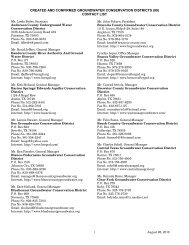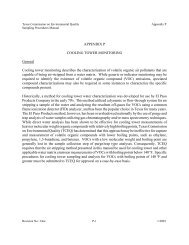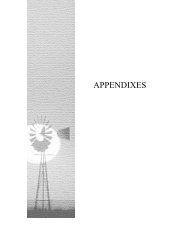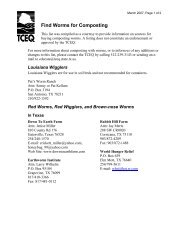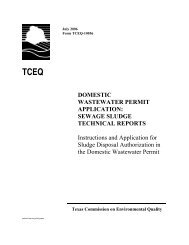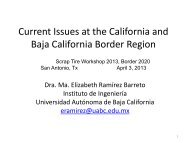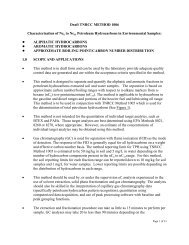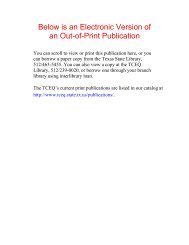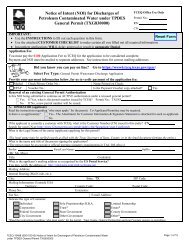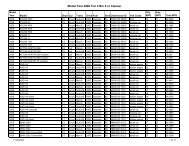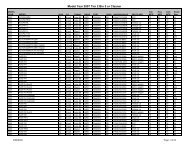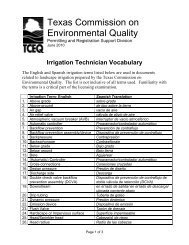to the north. There is a high demand for irrigati<strong>on</strong> and industrial water al<strong>on</strong>g the length <str<strong>on</strong>g>of</str<strong>on</strong>g> each river, andthe present flow <str<strong>on</strong>g>of</str<strong>on</strong>g> both the Pecos and the Rio Grande rivers is greatly reduced from historical levels. Earlytravelers’ accounts describe the Pecos, for example, as being wide, deep, and fast (4 to 15 feet deep and up to100 feet wide), and crossable at <strong>on</strong>ly a few safe fording points (Graves 2002).Riparian areas in the desert lowlands had been highly altered by the late 19 th century by the c<strong>on</strong>centrati<strong>on</strong><str<strong>on</strong>g>of</str<strong>on</strong>g> high numbers <str<strong>on</strong>g>of</str<strong>on</strong>g> cattle in the more productive areas close to streams. For example, in what is now BigBend Nati<strong>on</strong>al Park, meadows that <strong>on</strong>ce existed al<strong>on</strong>g Tornillo and Terlingua Creeks supported 30,000 cattlein 1891 (Gehlbach <str<strong>on</strong>g>199</str<strong>on</strong>g>3). In additi<strong>on</strong>, alien saltcedars (Tamarix spp.) and river cane (Phragmites australis)have invaded most riparian areas, <str<strong>on</strong>g>of</str<strong>on</strong>g>ten creating an impenetrable m<strong>on</strong>oculture al<strong>on</strong>g the banks. Saltcedars arephreatophytes, plants with deep roots that use significant amounts <str<strong>on</strong>g>of</str<strong>on</strong>g> ground water through evapotranspirati<strong>on</strong>,transpiring as much as 200 gall<strong>on</strong>s per day (Wuerthner 1989). As a result, besides displacing native riparianplant communities, saltcedars compete for scarce water supplies, and eradicati<strong>on</strong> efforts are underway tobulldoze, chain, plow, burn, or apply herbicide to thousands <str<strong>on</strong>g>of</str<strong>on</strong>g> acres <str<strong>on</strong>g>of</str<strong>on</strong>g> saltcedar to increase water yield.The paradox to this approach is that the frequent disturbance that is necessary to eliminate the saltcedar alsoeliminates native riparian plant growth and adds sediment to existing waterways. Burning <str<strong>on</strong>g>of</str<strong>on</strong>g> riparian areasalso occurs al<strong>on</strong>g the U.S. side <str<strong>on</strong>g>of</str<strong>on</strong>g> the Rio Grande, related to border c<strong>on</strong>trol issues.Although they may appear to be barren deserts, these sediment-filled basins can hold significant amounts<str<strong>on</strong>g>of</str<strong>on</strong>g> ground water in underground aquifers. Farmers depend <strong>on</strong> wells to irrigate cropland near El Paso (HuecoBasin), Pecos (Pecos River valley), and Dell City (Salt Basin) to produce cott<strong>on</strong>, pecans, alfalfa, tomatoes,<strong>on</strong>i<strong>on</strong>s, and chili peppers. Wells can yield several hundred to over 2000 gall<strong>on</strong>s per minute; however, overpumping<str<strong>on</strong>g>of</str<strong>on</strong>g> the aquifers risks infiltrati<strong>on</strong> <str<strong>on</strong>g>of</str<strong>on</strong>g> brackish water as well as earth subsidence caused by drawingdown the ground water level. In the El Paso area, ground water levels have declined over 100 feet since thebeginning <str<strong>on</strong>g>of</str<strong>on</strong>g> the 20 th century and demand for water there may so<strong>on</strong> exceed supply (U.S. Geological Survey2002). Irrigated agriculture may also be curtailed by salt buildup in the soil; large areas <str<strong>on</strong>g>of</str<strong>on</strong>g> formerly farmedfields have been aband<strong>on</strong>ed in the Pecos River valley.There are a number <str<strong>on</strong>g>of</str<strong>on</strong>g> lizard species in the shrub desert ecoregi<strong>on</strong>s (23a, 24a, and 24c) that can bec<strong>on</strong>sidered indicators <str<strong>on</strong>g>of</str<strong>on</strong>g> a particular ecoregi<strong>on</strong> because their habitat preferences coincide with the physicalcharacteristics defined for that ecoregi<strong>on</strong>. The lizards preferring the shrub desert habitats <str<strong>on</strong>g>of</str<strong>on</strong>g> Ecoregi<strong>on</strong> 24aare the side-blotched (Uta stansburiana), <str<strong>on</strong>g>Texas</str<strong>on</strong>g> horned (Phrynosoma cornutum), and little-striped whiptail(Cnemidophorus inornatus). The bird species most closely associated with creosote bush habitats is the blackthroatedsparrow (Amphispiza bilineata); other bird species are present <strong>on</strong>ly in proporti<strong>on</strong> to quantities <str<strong>on</strong>g>of</str<strong>on</strong>g>other types <str<strong>on</strong>g>of</str<strong>on</strong>g> shrubs (Gehlbach 1979, <str<strong>on</strong>g>199</str<strong>on</strong>g>3). The birds and lizards are active in the heat <str<strong>on</strong>g>of</str<strong>on</strong>g> the day; otherspecies, such as the kangaroo rat (Dipodomys spp.) and kit fox (Vulpes velox macrotis), cope with the desertenvir<strong>on</strong>ment by spending the day underground and venturing forth at night. The kit fox preys <strong>on</strong> insects,kangaroo rats, and jackrabbits (Lepus californicus) (which weigh the same as this diminutive fox). Thenumber <str<strong>on</strong>g>of</str<strong>on</strong>g> kit foxes has declined greatly due to pois<strong>on</strong>ing and trapping; it is a candidate species for listing <strong>on</strong>the U.S. Fish and Wildlife Service’s endangered species list (Schmidley 2002).Alien saltcedars (Tamarix spp.)and river cane (Phragmitesaustralis) have invaded riparianareas in the Chihuahuan Desertand replaced native vegetati<strong>on</strong>.Photo: Sandy BryceThe black-throated sparrow (Amphispiza bilineata) is closely associated withcreosote bush habitats in Chihuahuan Basins and Playas. It gets all the water itneeds from the seeds and insects that it eats. Photo: Nati<strong>on</strong>al Park Service<str<strong>on</strong>g>Ecoregi<strong>on</strong>s</str<strong>on</strong>g> <str<strong>on</strong>g>of</str<strong>on</strong>g> <str<strong>on</strong>g>Texas</str<strong>on</strong>g> 9
Level IV Ecoregi<strong>on</strong>24a. Chihuahuan Basins and PlayasArea (sq. mi.) 12,625Deep depressi<strong>on</strong>s or grabens filled with sediment to form flat to rolling basins. BasinsPhysiographyeither alluvial basins surrounding major river (Pecos, Rio Grande) or internallydrained (Salt Basin). Streams ephemeral.Elevati<strong>on</strong> /1200-4500 /Local Relief (feet)25-500Upper Pecos, Hueco, and Salt Basins: Holocene, Pleistocene, and late Tertiaryalluvium and erosi<strong>on</strong>al materials from surrounding mountains, includingSurficial Geology;unc<strong>on</strong>solidated basin deposits, silt, sand, and gravel. Lower Pecos: Holocene andBedrock GeologyPleistocene limest<strong>on</strong>e residuum and colluvium; Upper and Lower Cretaceouslimest<strong>on</strong>es.Mollisols (Calciustolls), Aridisols (Haplocalcids, Petrocalcids, Calcigypsids),Soil Order (Great Groups)Entisols (Torriorthents, Torripsamments)Basins, fans, and footslopes: Langtry, Zorra, Lozier, Shumla (lower Pecos R. valley),Comm<strong>on</strong> Soil SeriesHueco, Wink (Hueco Basin), Delnorte, Nickel, Reakor, Hoban, Upt<strong>on</strong> (Pecos Riverbasin). Salt Basin alkali flats: Holloman, Reeves. Sand sheets and dunes: Bluepoint.Soil Temperature /Thermic, Hyperthermic/Soil Moisture Regimes Aridic, Ustic AridicMean Annual Precipitati<strong>on</strong> (in.) 8-14Mean Annual Frost Free Days 220-250Mean Temperature (F) 25/60;(Jan. min/max; July min/max) 67/97Saline flats and alkaline playa margins: fourwing saltbush, seepweed, pickleweed,and alkali sacat<strong>on</strong>. Gypsum land: gyp grama, gyp mentzelia, and Torrey ephedra.Vegetati<strong>on</strong>Desert shrub land: creosote bush, tarbush, yuccas, sandsage, blackbrush, tasajillo,lechuguilla, and ceniza.Shrubland, remnant grassland, or barren land. Wildlife habitat, limited grazing, someLand Cover and Land Useurban and military land, some irrigated cropland.24b Chihuahuan Desert GrasslandsThe Chihuahuan Desert Grasslands occur in areas <str<strong>on</strong>g>of</str<strong>on</strong>g> fine-textured soils, such assilts and clays, that have a higher water retenti<strong>on</strong> capacity than coarse-textured, rockysoil. The grasslands occur in areas <str<strong>on</strong>g>of</str<strong>on</strong>g> somewhat higher annual precipitati<strong>on</strong> (10 to 18inches) than the Chihuahuan Basins and Playas (24a); these include elevated basinsbetween mountain ranges, low mountain benches and plateau tops, and north-facing highmountain slopes where natural erosi<strong>on</strong> or the effects <str<strong>on</strong>g>of</str<strong>on</strong>g> overgrazing have not removedthe soil. Desert grasslands also occur at lower elevati<strong>on</strong>s in areas <str<strong>on</strong>g>of</str<strong>on</strong>g> denser clay soil or where the water tableis near the surface, for example, in dry lake basins (playas) and alluvial riparian areas. In his 1857 report toC<strong>on</strong>gress, William Emory made regular observati<strong>on</strong>s <strong>on</strong> the grasslands his expediti<strong>on</strong> encountered duringthe U.S./Mexico Boundary Survey. Since Emory’s time, many <str<strong>on</strong>g>of</str<strong>on</strong>g> these grasslands in West <str<strong>on</strong>g>Texas</str<strong>on</strong>g> have beenreplaced by desert shrubland (Gehlbach <str<strong>on</strong>g>199</str<strong>on</strong>g>3). The evidence suggests that grazing levels in the late 19th andearly 20th centuries were unsustainable, and desert shrubs invaded the fragmented grass cover. Effectivemanagement strategies for grasslands take into account their fragile and erosive nature.The character <str<strong>on</strong>g>of</str<strong>on</strong>g> grasslands and their species assemblages differ between semidesert, mid-elevati<strong>on</strong>, andmountain grasslands. In low elevati<strong>on</strong> semidesert areas (2000 to 4500 feet) with lower rainfall, the arealcoverage <str<strong>on</strong>g>of</str<strong>on</strong>g> grasses may be sparse, 10% or less. Typical species include black, blue, and sideoats grama(Bouteloua spp.), bush muhly (Muhlenbergia porteri), beargrass (Nolina arenicola), and galleta (Pleuraphisjamesii), with scattered creosotebush (Larrea tridentata), acacias (Acacia spp.) and cacti (Opuntia spp.).When the grass cover becomes fragmented, it may be replaced by burrograss (Scleropog<strong>on</strong> brevifolius).Burrograss can <strong>on</strong>ly be eaten by cattle when young, and it spreads more aggressively because it can set seedeven in the driest weather when other grasses are dormant (Cottle 1931). At the same elevati<strong>on</strong> range, in valleybottoms and ancient lake beds with a high water table and clay soil, gramas are much less prevalent. The10<str<strong>on</strong>g>Ecoregi<strong>on</strong>s</str<strong>on</strong>g> <str<strong>on</strong>g>of</str<strong>on</strong>g> <str<strong>on</strong>g>Texas</str<strong>on</strong>g>
- Page 1: Below is an Electronic Version <str
- Page 4 and 5: ECOREGIONS OF TEXAS</strong
- Page 6 and 7: TABLE OF CONTENTSABSTRACT..........
- Page 8 and 9: 2526272526272330293235332430323423
- Page 10 and 11: INTRODUCTIONSpatial frameworks are
- Page 12 and 13: Maps of environmen
- Page 14 and 15: vegetation or small areas o
- Page 16 and 17: the only chipmunk in Texas<
- Page 20 and 21: taller, coarser tobosa grass (Pleur
- Page 22 and 23: the fractured rock. The Bof
- Page 24 and 25: hollows, moving upslope to create c
- Page 26 and 27: The headwater catfish (Ictalurus lu
- Page 28 and 29: streams. Two sand plains streams, C
- Page 30 and 31: Several caliche horizons (calcium c
- Page 32 and 33: winds (Spearing 199</strong
- Page 34 and 35: Geology is an important geographica
- Page 36 and 37: the villages of Pa
- Page 38 and 39: Area (sq. mi.) 5569PhysiographyFlat
- Page 40 and 41: Tableland topography of</st
- Page 42: y the Brazos and Colorado rivers ha
- Page 45 and 46: Level IV Ecoregion27i. Broken Red P
- Page 47 and 48: Post oaks (Quercus stellata) and bl
- Page 49 and 50: Level IV Ecoregion29c. Western Cros
- Page 51 and 52: than the limestone of</stro
- Page 53 and 54: underlying the sandstone. This has
- Page 55 and 56: Since settlement, many wildlife spe
- Page 57 and 58: (Pellaeae spp.), Nuttall’s stonec
- Page 59 and 60: Trinity-Edwards aquifer, discharges
- Page 61 and 62: Edwards Plateau to savanna-like con
- Page 63 and 64: species list, prefers fast moving w
- Page 65 and 66: Level IV Ecoregion31a. Northern Nue
- Page 67 and 68: 31c Texas-Tamaulip
- Page 69 and 70:
31d Rio Grande Floodplain and Terra
- Page 71 and 72:
62shrink when dry and swell when we
- Page 73 and 74:
32b Southern Blackland PrairieThe S
- Page 75 and 76:
33 EAST CENTRAL TE
- Page 77 and 78:
and need some patchy distubances an
- Page 79 and 80:
33d Northern Prairie OutliersThe sm
- Page 81 and 82:
Level IV Ecoregion33e. Bastrop Lost
- Page 83 and 84:
34a Northern Humid Gulf Coastal Pra
- Page 85 and 86:
34b Southern Subhumid Gulf Coastal
- Page 87 and 88:
occasional discontinuous drainage r
- Page 89 and 90:
oundary was the ability to match th
- Page 91 and 92:
Level IV Ecoregion34f. Lower Rio Gr
- Page 93 and 94:
live oak trees (Quercus virginiana)
- Page 95 and 96:
Shoal grass (Halodule wrightii) mea
- Page 97 and 98:
Upland oak-pine forest in Ecoregion
- Page 99 and 100:
35c Pleistocene Fluvial TerracesThe
- Page 101 and 102:
35f FlatwoodsMostly flat to gently
- Page 103 and 104:
pasture, although some woodland sti
- Page 105 and 106:
invariant definition of</st
- Page 107 and 108:
how many stream sites/watersheds ar
- Page 109 and 110:
commonly believed. Typically, about
- Page 111 and 112:
CONCLUSIONS AND RECOMMENDATIONSThis
- Page 113 and 114:
104Ecoregions <str
- Page 115 and 116:
Biggs, B.J.F., M.J. Duncan, I.G. Jo
- Page 117 and 118:
Diggs, G.M., Jr., and P.C. Schulze.
- Page 119 and 120:
Graves, J. 2002. Texas</str
- Page 121 and 122:
Hunt, C.B. 1967. Physiography <stro
- Page 123 and 124:
Maxwell, T.C. 1979. Avifauna <stron
- Page 125 and 126:
Richmond, G.M., D.L. Weide, and D.W
- Page 127 and 128:
U.S. Department of
- Page 129 and 130:
Woods, A.J., J.M. Omernik, D.R. But
- Page 131 and 132:
Herbaceous Plants(Forbs, Grasses, a
- Page 133 and 134:
Hickory, BlackHickory, WaterHollyHu



